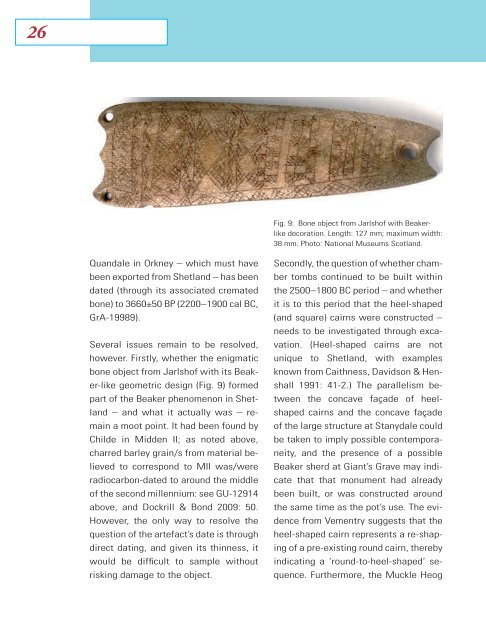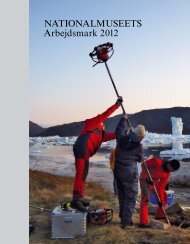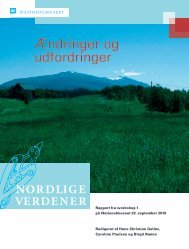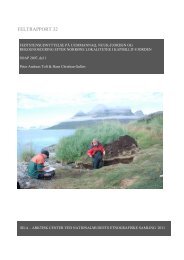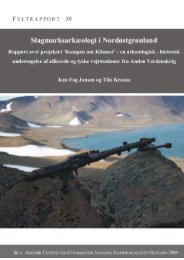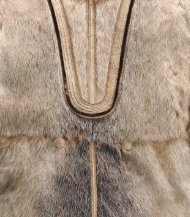The Border of Farming and the Cultural Markers - Nordlige Verdener
The Border of Farming and the Cultural Markers - Nordlige Verdener
The Border of Farming and the Cultural Markers - Nordlige Verdener
Create successful ePaper yourself
Turn your PDF publications into a flip-book with our unique Google optimized e-Paper software.
26<br />
Fig. 9: Bone object from Jarlsh<strong>of</strong> with Beakerlike<br />
decoration. Length: 127 mm; maximum width:<br />
38 mm. Photo: National Museums Scotl<strong>and</strong>.<br />
Qu<strong>and</strong>ale in Orkney – which must have<br />
been exported from Shetl<strong>and</strong> – has been<br />
dated (through its associated cremated<br />
bone) to 3660±50 BP (2200–1900 cal BC,<br />
GrA-19989).<br />
Several issues remain to be resolved,<br />
however. Firstly, whe<strong>the</strong>r <strong>the</strong> enigmatic<br />
bone object from Jarlsh<strong>of</strong> with its Beaker-like<br />
geometric design (Fig. 9) formed<br />
part <strong>of</strong> <strong>the</strong> Beaker phenomenon in Shetl<strong>and</strong><br />
– <strong>and</strong> what it actually was – remain<br />
a moot point. It had been found by<br />
Childe in Midden II; as noted above,<br />
charred barley grain/s from material believed<br />
to correspond to MII was/were<br />
radiocarbon-dated to around <strong>the</strong> middle<br />
<strong>of</strong> <strong>the</strong> second millennium: see GU-12914<br />
above, <strong>and</strong> Dockrill & Bond 2009: 50.<br />
However, <strong>the</strong> only way to resolve <strong>the</strong><br />
question <strong>of</strong> <strong>the</strong> artefact’s date is through<br />
direct dating, <strong>and</strong> given its thinness, it<br />
would be difficult to sample without<br />
risking damage to <strong>the</strong> object.<br />
Secondly, <strong>the</strong> question <strong>of</strong> whe<strong>the</strong>r chamber<br />
tombs continued to be built within<br />
<strong>the</strong> 2500–1800 BC period – <strong>and</strong> whe<strong>the</strong>r<br />
it is to this period that <strong>the</strong> heel-shaped<br />
(<strong>and</strong> square) cairns were constructed –<br />
needs to be investigated through excavation.<br />
(Heel-shaped cairns are not<br />
unique to Shetl<strong>and</strong>, with examples<br />
known from Caithness, Davidson & Henshall<br />
1991: 41-2.) <strong>The</strong> parallelism between<br />
<strong>the</strong> concave façade <strong>of</strong> heelshaped<br />
cairns <strong>and</strong> <strong>the</strong> concave façade<br />
<strong>of</strong> <strong>the</strong> large structure at Stanydale could<br />
be taken to imply possible contemporaneity,<br />
<strong>and</strong> <strong>the</strong> presence <strong>of</strong> a possible<br />
Beaker sherd at Giant’s Grave may indicate<br />
that that monument had already<br />
been built, or was constructed around<br />
<strong>the</strong> same time as <strong>the</strong> pot’s use. <strong>The</strong> evidence<br />
from Vementry suggests that <strong>the</strong><br />
heel-shaped cairn represents a re-shaping<br />
<strong>of</strong> a pre-existing round cairn, <strong>the</strong>reby<br />
indicating a ‘round-to-heel-shaped’ sequence.<br />
Fur<strong>the</strong>rmore, <strong>the</strong> Muckle Heog


